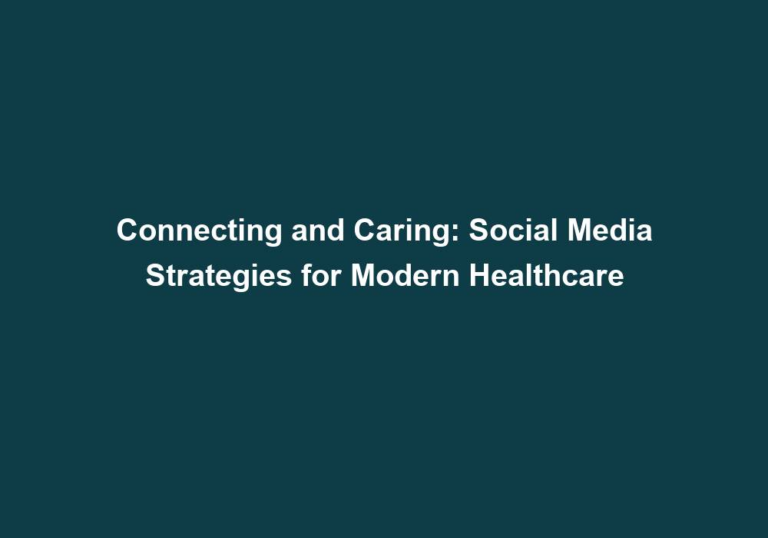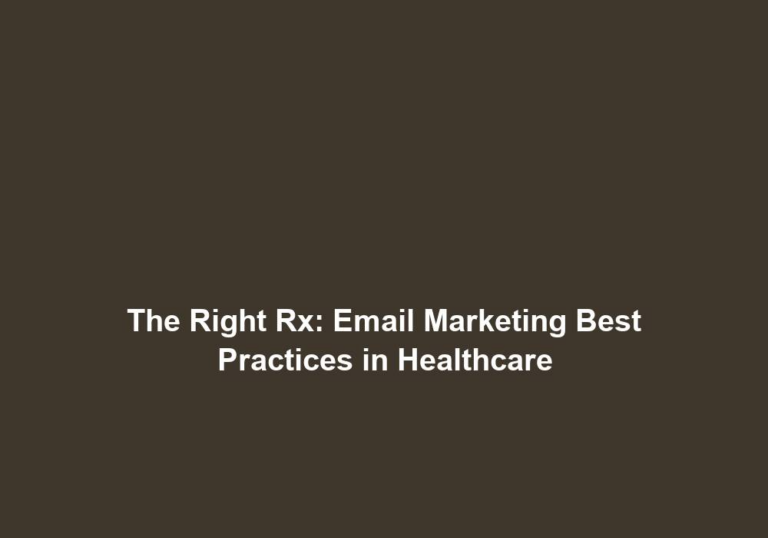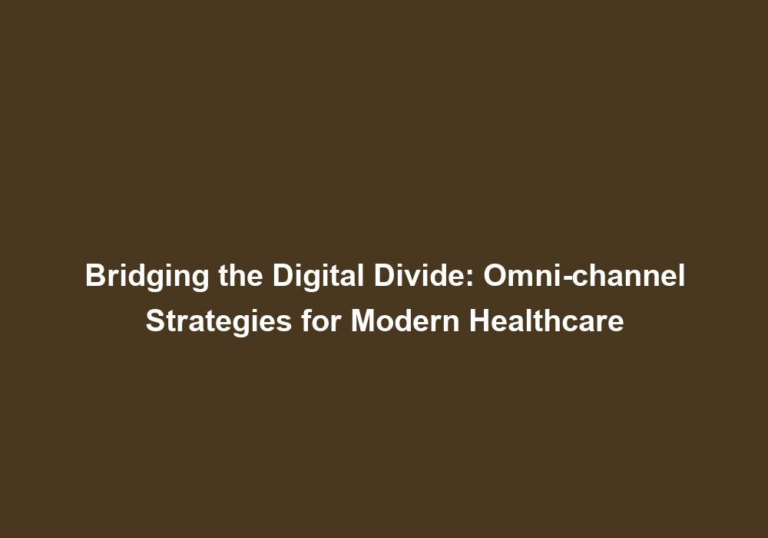The Right Rx: Email Marketing Best Practices in Healthcare
Email marketing has become an essential tool for businesses across various industries, including healthcare. In the ever-evolving digital landscape, effectively utilizing email marketing can help healthcare providers and organizations connect with their audience, build relationships, and drive patient engagement. However, to make the most out of your email marketing efforts, it is crucial to follow best practices that are specifically tailored to the unique needs and regulations of the healthcare industry. In this article, we will explore some key strategies and best practices to optimize your email marketing campaign in the healthcare sector.
1. Understand and Comply with Regulations
The healthcare industry is heavily regulated, and it is important to adhere to the various rules and regulations when implementing email marketing strategies. Familiarize yourself with laws such as the Health Insurance Portability and Accountability Act (HIPAA) to ensure the privacy and security of patient information. Make sure to obtain proper consent and permissions from patients before sending them any marketing emails. Being aware of and complying with these regulations will not only maintain legal compliance but also enhance trust and credibility with your audience.
In addition to HIPAA, there may be other regulations specific to your region or country that you need to consider. For example, the General Data Protection Regulation (GDPR) in the European Union requires explicit consent from individuals before sending them marketing emails. It is essential to stay up-to-date with the evolving regulatory landscape and ensure your email marketing practices align with the latest requirements.
To comply with regulations, consider implementing secure email systems that encrypt sensitive patient information. This adds an extra layer of protection and ensures that patient data remains confidential. Regularly train your staff on privacy and security protocols to maintain compliance and minimize the risk of data breaches.
2. Segment Your Email List
Segmenting your email list is a powerful technique that allows you to personalize your email content and target specific groups of recipients. In the healthcare industry, different patients have unique needs and concerns. By segmenting your email list based on demographics, health conditions, or interests, you can deliver tailored content that resonates with each group. This personalized approach increases the likelihood of engagement, improves patient satisfaction, and ultimately drives better results.
When segmenting your email list, consider factors such as age, gender, location, medical history, and preferences. For example, you can create segments for patients with chronic conditions, expectant mothers, or individuals interested in preventive care. By understanding the specific needs and interests of each segment, you can craft targeted messages that address their concerns and provide relevant information.
Segmentation also allows you to implement targeted email campaigns for specific healthcare services or initiatives. For instance, you can send specialized emails promoting flu vaccines during flu season or reminders for annual check-ups based on age and gender. This level of personalization demonstrates that you understand your patients’ needs and helps establish a stronger connection with them.
3. Craft Compelling Subject Lines
Subject lines are the first impression your email makes on recipients. Crafting compelling and attention-grabbing subject lines is crucial to pique the interest of your audience and encourage them to open your emails. However, in the healthcare industry, it is essential to balance creativity with transparency. Avoid using misleading or sensationalist subject lines, as they may undermine the trust and credibility you have established. Opt for concise and informative subject lines that accurately reflect the content of the email.
To create compelling subject lines, consider using action-oriented language that generates curiosity or offers a clear benefit to the recipient. For example, instead of using a generic subject line like “Newsletter – November Edition,” try something more engaging like “Discover the Secrets to a Healthier Lifestyle Inside!” or “Get Exclusive Access to Our Latest Research Findings.”
Personalization can also enhance the effectiveness of your subject lines. Include the recipient’s name or reference their specific health condition or interests to make the email feel more tailored to their needs. A subject line like “John, Learn How to Manage Your Diabetes with Our New Guide” is more likely to capture attention compared to a generic subject line.
In addition to subject lines, preview text is another valuable element to consider. The preview text gives recipients a glimpse of the email content before they open it fully. Make sure the preview text complements the subject line and provides a compelling reason for the recipient to click and explore further.
4. Provide Valuable and Relevant Content
Delivering valuable and relevant content is the key to successful email marketing in healthcare. Provide your subscribers with useful information, such as health tips, educational resources, or updates on the latest medical breakthroughs. Tailor the content to the specific interests and needs of each segment of your email list. Additionally, consider incorporating visual elements, such as infographics or videos, to enhance engagement and improve the user experience. By consistently delivering high-quality content, you position yourself as a trusted resource in the eyes of your patients.
When creating content for your healthcare email campaigns, focus on providing actionable advice and practical tips that benefit your subscribers. Address common health concerns, debunk myths, and share success stories to establish yourself as a reliable source of information. Consider collaborating with healthcare professionals or experts in your network to contribute guest articles or provide insights on specific topics.
Remember to strike a balance between educational content and promotional material. While it is important to promote your services or products, avoid overwhelming your subscribers with excessive sales pitches. Instead, focus on building trust and credibility by providing valuable content that genuinely helps your audience.
To further enhance engagement, consider including interactive elements in your emails. For example, you can include quizzes, surveys, or polls to encourage active participation from your subscribers. This not only provides valuable feedback but also makes the email experience more interactive and enjoyable.
5. Optimize for Mobile
With the increasing use of smartphones and mobile devices, optimizing your email marketing campaigns for mobile is a must. Ensure that your emails are mobile-friendly and responsive, meaning they adapt to different screen sizes and resolutions. A mobile-optimized email provides a seamless experience for users and increases the chances of them engaging with your content. Pay attention to the formatting, font size, and overall readability when designing emails to ensure a smooth mobile experience.
When optimizing for mobile, keep in mind that mobile users have shorter attention spans and limited screen space. Therefore, it is crucial to prioritize the most important information and use concise and scannable content. Break up long paragraphs into smaller sections, use bullet points or numbered lists to highlight key points, and make sure your call-to-action buttons are easily clickable on a mobile screen.
Test your emails on different mobile devices and email clients to ensure they render correctly. Consider using responsive email templates or email marketing platforms that offer mobile optimization features. By providing a seamless mobile experience, you increase the chances of capturing your audience’s attention and driving them to take the desired action.
6. Encourage User Interaction and Feedback
Email marketing should be a two-way communication channel. Encourage user interaction and feedback by including clear calls-to-action (CTAs) in your emails. Whether it’s inviting patients to book an appointment, participate in a survey, or join a support group, CTAs create opportunities for engagement and foster a sense of involvement. Additionally, actively seek feedback from your recipients to gain insights into their preferences, needs, and suggestions. This feedback can help you refine your email marketing strategies and improve patient satisfaction.
When designing your CTAs, make them visually appealing and place them strategically within your email content. Use contrasting colors, clear fonts, and compelling copy to draw attention. Consider using action verbs to prompt immediate action, such as “Book Now,” “Learn More,” or “Join Today.”
In addition to CTAs, encourage social sharing by including social media buttons in your emails. This allows recipients to easily share your content with their networks, extending the reach of your email campaigns and potentially attracting new subscribers.
Actively seek feedback from your subscribers through surveys or feedback forms. Ask them about their preferences, interests, and any suggestions they may have for improving your email content or overall healthcare services. Analyzing this feedback can provide valuable insights for refining your email marketing campaigns and tailoring them to better meet the needs of your audience.
7. Monitor and Analyze Performance
Regularly monitoring and analyzing the performance of your email marketing campaigns is essential to understand what works and what doesn’t. Use email marketing analytics tools to track important metrics such as open rates, click-through rates, conversion rates, and unsubscribe rates. Analyzing this data allows you to identify trends, evaluate the effectiveness of your content, and make data-driven decisions to optimize future campaigns. By continuously improving and refining your email marketing efforts, you can achieve better results and maximize the impact of your healthcare marketing initiatives.
Pay attention to metrics beyond just open and click rates. Look at conversion rates to understand how effective your email campaigns are in driving the desired actions, such as appointment bookings or newsletter sign-ups. Analyze the performance of different segments to identify which groups are most responsive to your emails and tailor your strategies accordingly.
A/B testing is another valuable technique to optimize your email marketing campaigns. Test different subject lines, content formats, or CTAs to identify the most effective elements. By experimenting and analyzing the results, you can refine your emails over time and continuously improve their performance.
In conclusion, implementing effective email marketing strategies in the healthcare industry requires a thorough understanding of the unique challenges and regulations that govern this sector. By following best practices such as understanding and complying with regulations, segmenting your email list, crafting compelling subject lines, providing valuable content, optimizing for mobile, encouraging user interaction, and monitoring performance, you can build a successful email marketing campaign that engages patients, builds trust, and drives positive outcomes in the healthcare field.






